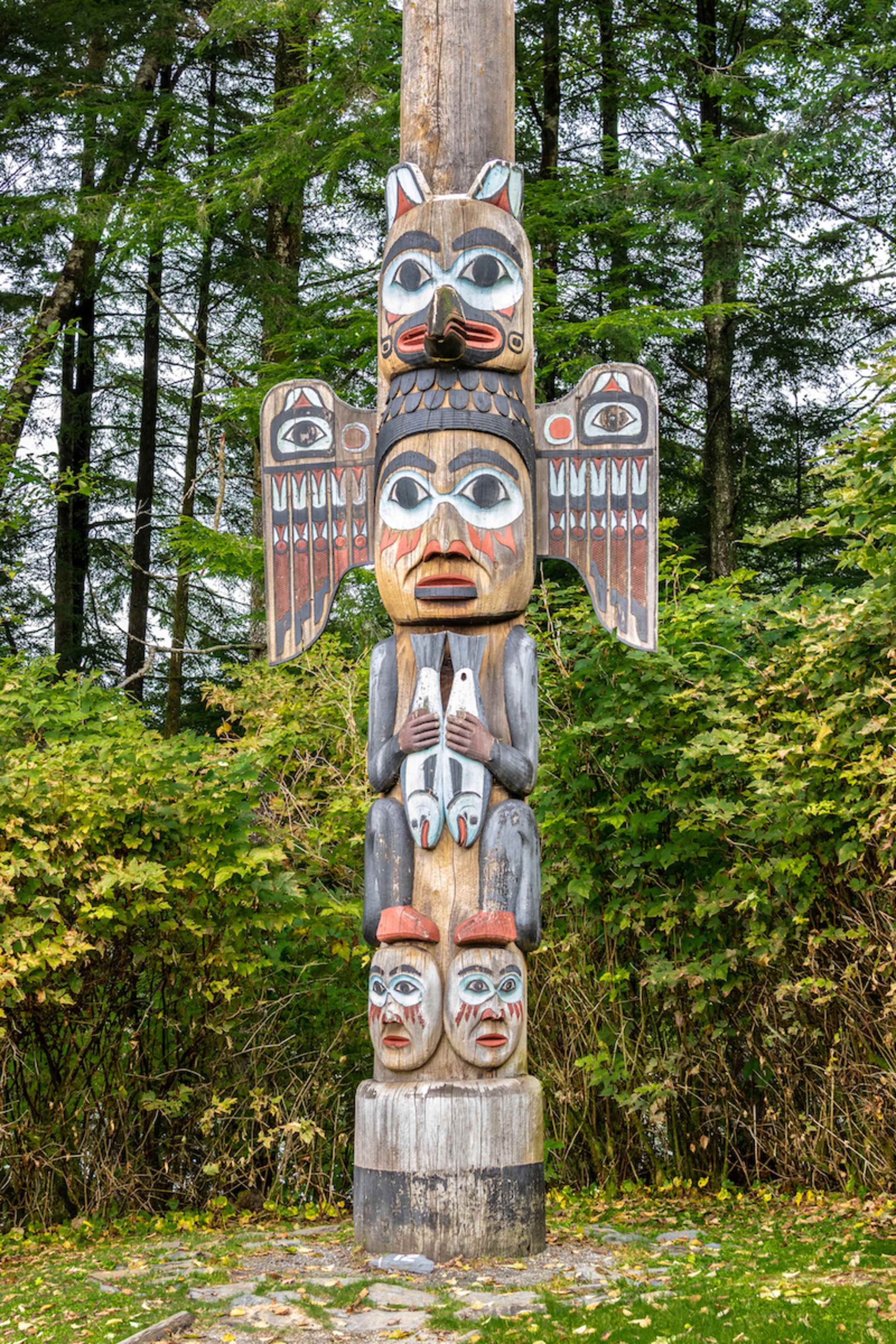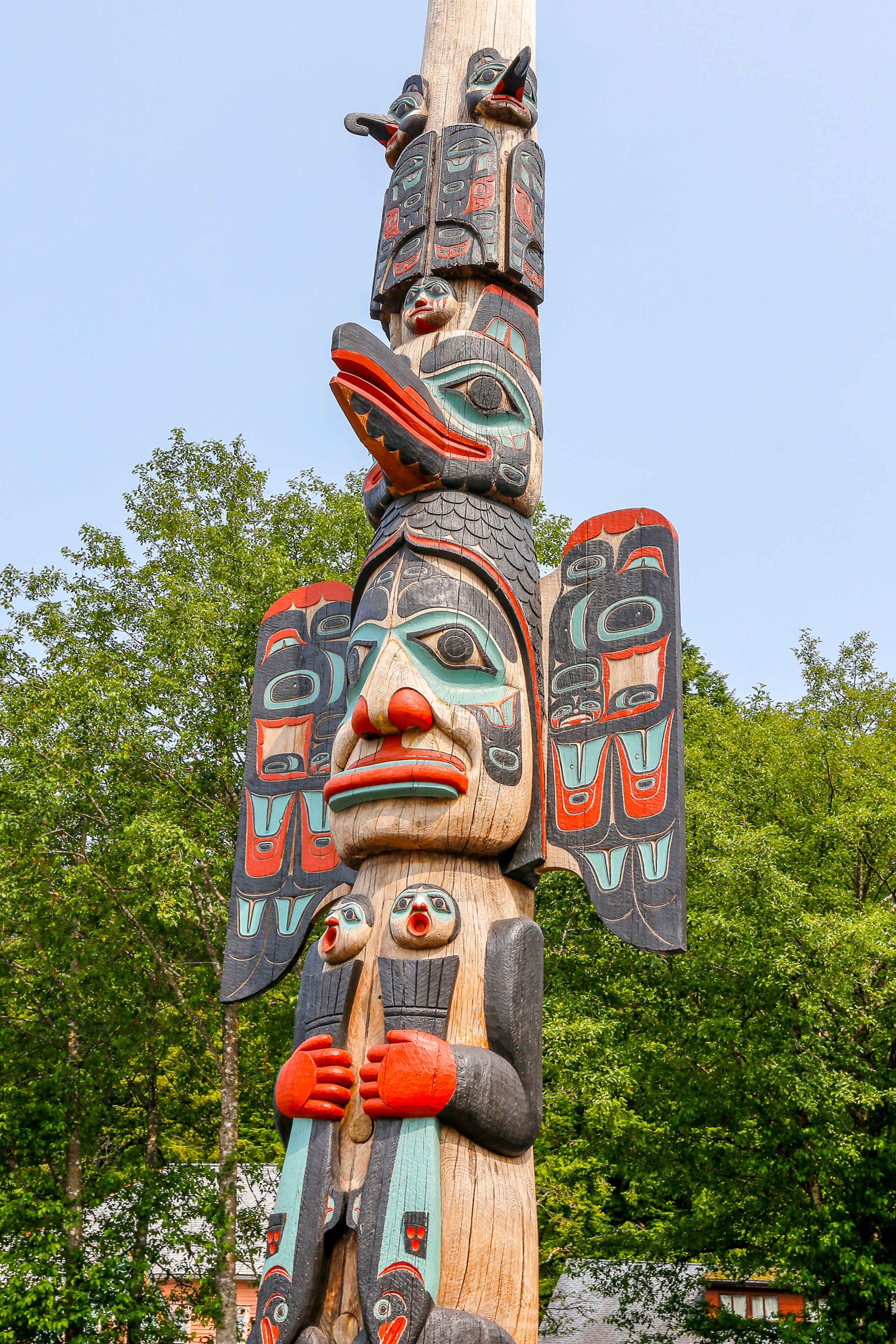
Alaska's Art of the Totem Pole
Once nearly lost, the art of totem pole carving now carries the Alaskan past into the future.

There are faces in the forest, eyes swirling in the mist, as I walk along a quiet path in Alaska’s Sitka National Historical Park. There is the fog cloaked form of a village watchman; a whale with a long, black dorsal fin; a raven holding a piece of the crescent moon. At one bend in the trail there stands a form half bear, half man. At another I find a frog, a wolf, and the curved beak of an eagle. All of them are silent. All of them are still. And all of them are carved out of wood.
History of the Totem Pole
The totem pole is one of the most dramatic expressions of Pacific Northwest Coast heritage. Rising sometimes 60 feet into the air, totem poles are exclamation points on the vibrant cultures of the Tlingit, Haida, and Tsimshian people of southeastern Alaska. A century ago, an estimated 600 poles bristled in the coastal villages of Alaska’s Inside Passage. Most often they were carved from immense red cedars and colored with natural pigments. Some were crest poles depicting a family’s ancestral clan; others were history poles that recorded events important to a clan. Legend poles represented favorite stories, and memorial poles honored the lives of prominent individuals.
In a society without a written language, totem poles were, in essence, stories carved in wood. But to European explorers in the 1700s looking at them across seemingly unbridgeable gaps of culture and time, the faces were only monstrous figures. Early missionaries incorrectly considered them pagan idols and banned their carving. Poles were chopped down by vandals, sold to collectors, or left to topple. An entire art form began to disappear into the forest floor.
But slowly, growing recognition of the poles’ historic and artistic value bridged that gap of understanding. A renewed interest in the dramatic art of totem poles sprang from the mists. Native carvers restored old poles and created replicas, then began carving new poles for museums, city parks, and private collectors. Contemporary carvers are careful to carry the traditions of the past into the future by honoring the historic symbolism while continuing to move the art in a new direction.
"Totem poles put us on the map," says Nathan Jackson, one of the forces behind that renaissance. "They speak of who we are." A member of the Sockeye clan of the Chilkoot Tlingit, Jackson is a master carver with more than 50 poles to his credit, including works in major museums throughout the United States, Europe, and Japan. Despite the acclaim, he smiles at the thought of being considered an artist. "The Tlingit language has no word for art," he says. "Sometimes I feel more like a trailblazer going back to brush out a trail that almost disappeared before it could be followed again.

Totem Trails in Southeast Alaska
Thanks to the work of Jackson and others, visitors can walk totem trails at several locations in southeast Alaska. The Totem Heritage Center in Ketchikan houses the world’s largest collection of 19th-century totem poles. Many of the examples on display would not exist were it not for the center. Collected in the late 1960s from remote villages before they could vanish from benign neglect, many of the center’s poles are over 150 years old and as fragile as moth wings. The carvings still tell their tales to researchers, artists, and visitors.
Totem Bight State Historical Park, the site of a restoration project begun in 1938 by the U.S. Forest Service and native carvers, takes a different direction in the preservation of old poles. As with the Totem Heritage Center, poles are gathered from outlying villages. They become the patterns for copies created by carvers using traditional methods. Today, visitors go by 14 poles, including a Haida mortuary pole and a Raven house entrance pole. A clan house sits at the end of the trail and looks out over the Tongass Narrows.

Totem carving is more of a living art form in Saxman Totem Park, three miles south of Ketchikan. The park displays 25 totem poles outdoors, including a copy of the famous pole honoring President Lincoln, as well as the intricately carved indoor posts of the Beaver Tribal House. But the beating heart of the park is the carving shed. Step through the doors, and the smell of cedar envelops you. Wood shavings muffle your footsteps. You hear the soft chuck-chuck-chuck of an adze as carvers release the shapes of eagles, ravens, and whales from the wood.
Here, you can see totem carving in action through demonstrations, classes, and tours. The center has been the artistic home of carvers such as Nathan Jackson and Lee Wallace as well as a long line of apprentices, proof that the art form is alive and well. "I always react negatively when I am called the ‘last Tlingit carver,’ " Jackson says. "All you have to do is look around the Carving Center and you can see there’s a lot of carvers on the horizon."
The personal styles of totem carvers past and present become obvious on a walking tour of downtown Juneau. A dozen examples greet you within just a few blocks, including the Governor’s Totem Pole from 1939, outside the Governor’s Mansion, and the Old Witch Totem Pole carved in the late 1800s, now standing inside the State Office Building. There are others on display outside Centennial Hall, inside the Alaska State Museum, and in the courthouse lobby.
Still, on a misty day, my favorite place to see poles is the Totem Loop Trail in Sitka National Historical Park. The quiet path leads along the water to 12 of them set subtly among the mossy shadows of spruce trees. They are replicas of those collected in the early 1900s by Alaska’s fifth territorial governor, John G. Brady. The visitor center features carving demonstrations, classes, guided tours, and a park movie. But to see the poles in a proper setting, slip out the back door and walk the trail with the waves whispering on the nearby shore and the mist in the trees. You are in a forest of faces.

Story of the Totem Pole
Though the figures on a totem pole sometimes create a story line leading from the top downward, poles weren’t meant to be "read" in the usual sense of the word. Instead, each symbol, each face, is a reminder of a story perhaps thousands of years old that echoed in the carver’s mind and took shape as he worked. Some are easy to recognize—raven, eagle, whale. Others are less clear. For example, a tongue extended symbolizes the transfer of wisdom through speech.
"Traditionally the story of the pole was told at the potlatch or celebration that was held when it was first erected," Jackson says. "After that, the story became a tool to educate the younger people of that clan and would be retold to them periodically."
It is true that different people might tell it somewhat differently, depending on their focus. Just looking at a pole doesn’t necessarily tell you the story, but if you have an idea of what the story is, the carvings will remind you. The stories are traditional; some have survived, while others have been lost.
Still, totem poles connect the past to what lies ahead. Jackson’s son, Stephen, whose first major work, a pole honoring the Auk tribe, stands in the Mount Roberts Tramway building on Juneau’s waterfront, notes, "Art forms evolve, but they are still about us, in the present looking forward and backward, trying to find what will help us create things of beauty and relevance."
With artists preserving carving traditions and blazing new trails in the medium, it’s easy to believe there will always be places to walk through the forests where faces rise from the mist.